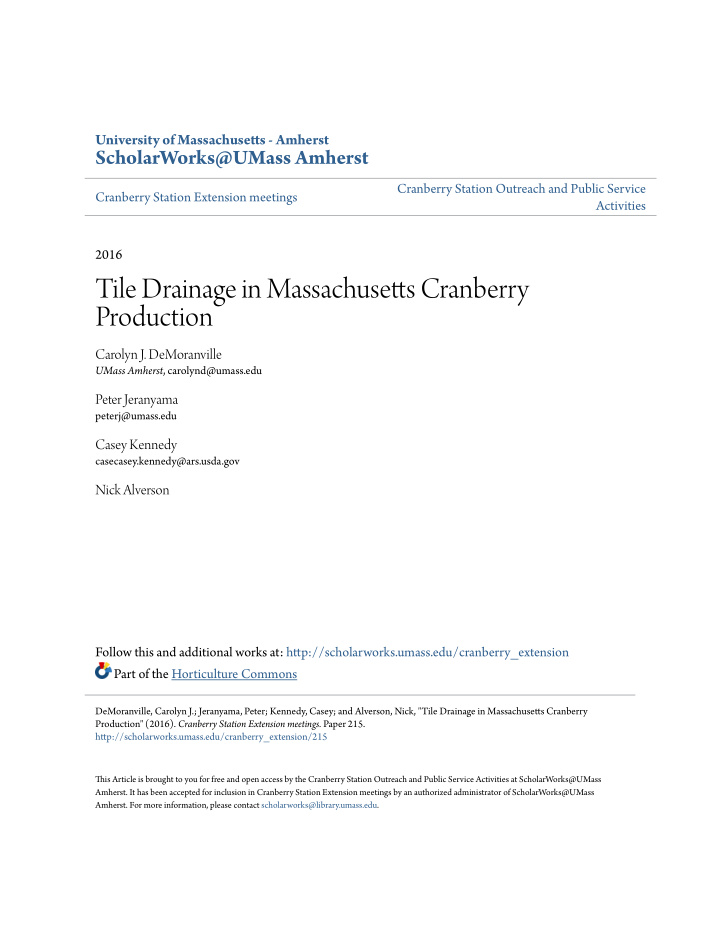



University of Massachusetus - Amherst ScholarWorks@UMass Amherst Cranberry Station Outreach and Public Service Cranberry Station Extension meetings Activities 2016 Tile Drainage in Massachusetus Cranberry Production Carolyn J. DeMoranville UMass Amherst , carolynd@umass.edu Peter Jeranyama peterj@umass.edu Casey Kennedy casecasey.kennedy@ars.usda.gov Nick Alverson Follow this and additional works at: htup://scholarworks.umass.edu/cranberry_extension Part of the Horticulture Commons DeMoranville, Carolyn J.; Jeranyama, Peter; Kennedy, Casey; and Alverson, Nick, "Tile Drainage in Massachusetus Cranberry Production" (2016). Cranberry Station Extension meetings. Paper 215. htup://scholarworks.umass.edu/cranberry_extension/215 Tiis Article is brought to you for free and open access by the Cranberry Station Outreach and Public Service Activities at ScholarWorks@UMass Amherst. It has been accepted for inclusion in Cranberry Station Extension meetings by an authorized administrator of ScholarWorks@UMass Amherst. For more information, please contact scholarworks@library.umass.edu.
Tile drainage in Massachuse0s cranberry produc5on Carolyn DeMoranville, Peter Jeranyama, Casey Kennedy, and Nick Alverson • Funded by Northeast SARE • Looked at spacing: horizontal and ver>cal (depth) • Looked at func>onality
Tile Drainage Study - spacing Tile # of # of upright # of uprights Yield (BBL) Spacing, vegeta>ve with 1 berry ≥ 1 berry L -2 feet uprights L -2 L -2 15 36 7 20 270 20 50 11 28 339 25 55 12 24 307 Contrasts 15 vs. 20 NS ** * * 15 vs.25 * ** NS NS 20 vs. 25 NS NS NS NS
Tile depth study Soil tension (kPa) Peat 8" Peat 12" Upland 12" 0 -0.5 -1 -1.5 -2 -2.5 -3 -3.5
Tile depth/drainage – Fruit Rot Fruit rot (%) 25 Depth 20 mabers but 15 so does subsoil base 10 5 0 Peat 8" Peat 12" Upland 12"
Soil Tension and Tile Drainage Depth Effects on Cranberry Yield 500 450 400 Berry Yield (BBL/Acre) 350 300 250 200 150 100 50 0 shallow/wet regular/wet regular/dry
Tile drain func>on TD4$ TD3$ - Cranberry$Bed$ $ - Drainage$ Ditch$ - Sampling$site$ - Discharge$ Flume$ - Input$Flume$ $ - Flow$DirecEon$ Ditch eleva>on lower of$ditch$ at this end - Drainage$Ele$ TD2$ TD1$ FLUME$
Case study – the work of graduate student Nick Alverson Depth: 18 in. sloping to 2 L. Width: 25 L.
Hydrologic Inputs – inches of water irrigation 1.17 1.48 precip flood input Input from adjacent bed 4.10 6.50
Surface Water Discharge: Storms vs. Harvest Flood Feet (normalized to 5 acre bed) Drainage rate: 1.40 ~100x vol. per sec. 1.20 vs. storm 1.00 0.80 0.60 0.40 0.20 0.00
August Storm Event - Flow 0.8 0.7 cubic feet per second 0.6 0.5 0.4 0.3 0.2 0.1 0
Total Discharge from Bed vs Discharge from Tiles (cubic meters) 2014 40000 Discharge from >les represents 33390 approximately 42% of the flow 30000 20000 14260 10000 5319 4576 2502 1863 0 total total >le TD1 TD2 TD3 TD4 discharge discharge
Survey • Have asked ques>ons about your use of >les • Today’s survey will be used to provide the ‘end of project’ informa>on to compare to start. • Two more workshops in the spring – depth and installa>on
Recommend
More recommend